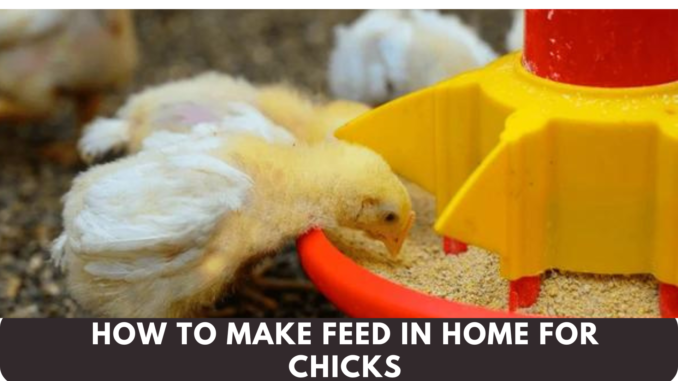
Chick Nutrition
Chicks require a balanced diet to thrive and grow into healthy chickens. Understanding their nutritional needs is the first step to creating homemade feed that supports their development.
Essential Nutrients for Healthy Growth
Chicks need a variety of nutrients, including proteins, carbohydrates, vitamins, and minerals. Each of these plays a crucial role in their growth.
- Proteins are essential for muscle development.
- Carbohydrates provide energy for daily activities.
- Vitamins support immune function and overall health.
- Minerals like calcium and phosphorus are vital for bone development.
The Role of Protein, Vitamins, and Minerals
It’s essential to provide adequate levels of these nutrients in your homemade feed. A balanced diet ensures that chicks grow strong and healthy. For instance, protein is particularly crucial in the early stages of life, while minerals support bone health as they grow.
Ingredients for Homemade Chick Feed
Creating your own chick feed at home allows you to control the quality and type of ingredients used.
Grains and Seeds
The base of any chick feed should be grains. Common options include:
- Corn: A great source of energy.
- Wheat: Offers essential nutrients and is easy to digest.
- Barley: High in fiber and supports digestion.
Protein Sources
To ensure your chicks receive enough protein, consider adding:
- Soybean meal: A common ingredient in commercial feeds.
- Fish meal: Rich in amino acids.
- Mealworms: A natural protein source that chicks love.
Supplements for Balanced Nutrition
To further enhance the nutritional profile, consider adding:
- Oyster shell: Provides calcium for strong eggshells as they mature.
- Brewer’s yeast: Rich in B vitamins and supports overall health.
Equipment Needed
Before you start making your chick feed, ensure you have the right tools.
Mixing Tools
You’ll need:
- Large mixing bowl: For combining ingredients.
- Measuring cups: To ensure accurate proportions.
Storage Containers
After mixing, store your feed in airtight containers to maintain freshness. Glass jars or plastic bins work well for this purpose.
Step-by-Step Guide to Making Chick Feed
Now that you have your ingredients and tools, follow these steps to create nutritious feed for your chicks.
Preparing the Ingredients
Start by gathering all your ingredients. Clean and measure each item before mixing.
Mixing Ratios and Techniques
A good starting point for a homemade chick feed could be:
- 50% grains (corn, wheat)
- 20% protein (soybean meal)
- 30% supplements (oyster shell, vitamins)
Mix thoroughly to ensure an even distribution of nutrients.
Storage Tips for Freshness
Store your homemade chick feed in a cool, dry place. Always use airtight containers to keep out moisture and pests, ensuring your feed stays fresh for longer.
Customizing Feed for Different Age Groups
As your chicks grow, their nutritional needs will change. Here’s how to customize their feed.
Starter Feed for Chicks
For newly hatched chicks, a starter feed should contain around 20-24% protein to promote rapid growth.
Grower and Finisher Feeds
As they mature, you can switch to grower feed (16-18% protein) and then finisher feed (14-16% protein) as they approach adulthood.
Troubleshooting Common Issues
Even with homemade feed, you may encounter some challenges.
Recognizing Nutritional Deficiencies
Watch for signs of deficiency, such as feather pecking or poor growth. If you notice these issues, reassess your feed recipe.
Adjusting Recipes for Healthier Chicks
If your chicks are not thriving, consider adjusting the protein levels or adding different grains to ensure a balanced diet.
Benefits of Homemade Feed
Making your own chick feed comes with numerous advantages.
Cost-Effectiveness
Homemade feed can often be cheaper than store-bought alternatives, especially if you buy ingredients in bulk.
Quality Control
You can ensure that your chicks are getting high-quality ingredients free from additives and preservatives.
Frequently Asked Questions (FAQs)
What ingredients should I avoid?
Avoid using moldy or spoiled grains, and steer clear of processed foods that may contain additives harmful to chicks.
How long can homemade feed be stored?
Homemade feed can generally be stored for up to six months if kept in airtight containers in a cool, dry place.
Can I use leftovers in chick feed?
While it’s best to stick to whole grains and natural ingredients, small amounts of fresh, unseasoned leftovers can be added in moderation.
How to ensure a balanced diet?
Refer to nutritional guidelines for chicks and adjust your recipes based on their growth stage and needs.
Is it safe to feed chicks scratch grains?
Scratch grains can be given as treats but should not replace a balanced feed designed for their age.
How often should I feed my chicks?
Chicks should have constant access to feed, ensuring they can eat as needed.
Conclusion
Making your own chick feed at home is a rewarding and beneficial practice that can lead to healthier, happier chickens. By understanding their nutritional needs and using quality ingredients, you can ensure that your chicks thrive from day one.
Leave a Reply